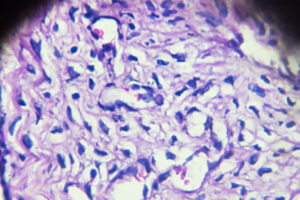The combination of mirvetuximab soravtansine and bevacizumab produces “impressive antitumor activity” in patients with recurrent ovarian cancer and high folate receptor alpha (FRα) expression, according to researchers.
David M. O’Malley, MD, of The Ohio State University Wexner Medical Center in Columbus, and colleagues presented these findings at the 2021 American Society of Clinical Oncology (ASCO) Annual Meeting.1
The phase 1/2 study (ClinicalTrials.gov Identifier: NCT02606305) included 60 patients with platinum-sensitive (47%) or platinum-resistant (53%) ovarian cancer. The patients received mirvetuximab soravtansine at 6 mg/kg plus bevacizumab at 15 mg/kg on day 1 of a 21-day cycle.

The results presented at ASCO 2021 build on previously published data showing that mirvetuximab soravtansine was well tolerated and produced a confirmed objective response rate (ORR) of 39%.2
At a median follow-up of 17.5 months, the updated results showed an ORR of 47%. The median duration of response (DOR) was 9.7 months, and the median progression-free survival (PFS) was 8.3 months.
Looking specifically at patients with high FRα expression, the ORR increased to 64%, the median DOR was 11.8 months, and the median PFS was 10.6 months.
Among patients with high FRα expression and platinum-resistant disease, the ORR was 59%, the median DOR was 9.4 months, and the median PFS was 10.1 months.
Patients with high FRα expression and platinum-sensitive disease had the highest ORR, at 69%. They also had the longest median DOR, at 12.9 months, and the longest median PFS, at 13.3 months.
Common treatment-related adverse events included diarrhea (68%), blurred vision (63%), fatigue (58%), and nausea (57%). Common grade 3 or worse adverse events included neutropenia and hypertension.
References
- O’Malley DM, Oaknin A, Matulonis UA, et al. Mirvetuximab soravtansine, a folate receptor alpha (FRα)-targeting antibody-drug conjugate (ADC), in combination with bevacizumab in patients (pts) with platinum-agnostic ovarian cancer: final analysis. J Clin Oncol. 2021;39:(suppl 15; abstr 5504). doi:10.1200/JCO.2021.39.15_suppl.5504
- O’Malley DM, Matulonis UA, Birrer MJ, et al. Phase Ib study of mirvetuximab soravtansine, a folate receptor alpha (FRα)-targeting antibody-drug conjugate (ADC), in combination with bevacizumab in patients with platinum-resistant ovarian cancer. Gynecol Oncol. 2020;157(2):379-385. doi:10.1016/j.ygyno.2020.01.037
This article was published by Cancer Therapy Advisor.


